Most of us just aren’t fans of bitter foods. Kids usually hate them, and as adults, most of us tolerate them at most. But why is that? Well, there’s actually an evolutionary reason behind it. Because most poisonous things are bitter in taste, our senses were taught to steer clear of that flavor.[1] It was a survival technique.
As we’ve evolved, we now know that some bitter foods are actually good for us. They can help detox your digestive tract, suppress your appetite, and improve your overall health.[2] Yet, our natural dislike for the flavor makes it hard for many of us to reap the benefits of bitter foods.
We’ll share some information about bitter foods (including the difference between bitter vs sour) and easy tips on how to add them to your meals for a healthy, natural detox. We’ve also included a handy bitter food examples list so you know exactly what to add to your shopping cart.
What Is Bitter vs Sour?
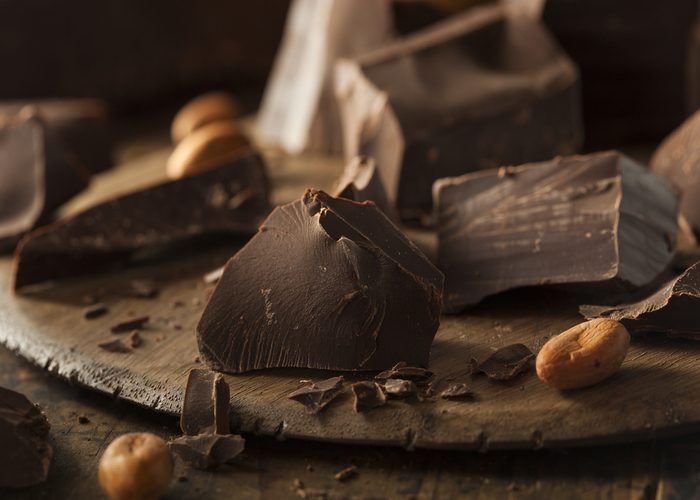
Wondering what the difference is between bitter vs sour? The best place to start is by considering some background info about our taste receptors. Humans have five taste receptors: sweet, salty, sour, umami (savory), and bitter. These receptors help you interpret a food’s flavor. To give you a better picture of how many receptors you have in your body, look in a mirror and stick out your tongue. You’ll notice you have many tiny little taste buds on your tongue. Each of these tiny taste buds contains about 10-15 taste receptors.[3]
An average person has about 10,000 taste buds on their tongue, so you can just imagine how many receptors you have in your mouth alone! These receptors can also be found in your throat and digestive tract. They send messages to your brain about what nutrients are in the food you are about to eat.[4]
When you taste a bitter food, your bitter receptors are activated and your neurons tell your brain to prepare the gut for digestion.[5] Then, the receptors in your GI tract begin moving the stomach. They also prepare to break down the nutrients coming their way.
A common mistake in identifying bitter foods is not knowing the difference between sour and bitter. There is a big distinction in their taste and health benefits. So once you learn how to tell the two apart, it’ll be easier to improve your diet with both. Here are a few pointers to finally wrap your head around bitter vs sour.
Bitter foods aren’t the best to eat raw

To understand bitter taste, think of the white rind of a lemon or orange (the part you avoid when grating the zest). Additionally, black coffee and dark, sugar-free cocoa are also bitter in taste.
Bitter foods are usually not pleasant to eat raw or in an unmodified form. But once they are cooked or added to a dish with another of the five receptor tastes, they can become really enjoyable. For example, brussels sprouts are a bitter food that would make your tongue recoil if you tried to eat it raw. But when cooked, they become a delicious mix of savory and bitter.
Fun Fact: A colorful plate for dinner may keep you from wanting dessert later. Studies show that having a variety of colorful foods in a meal will decrease later consumption of sugar.[6]
Sour foods give us the signature “scrunch face”

Sour tasting foods are more distinguishable because they have a strong “zing” to them. Plain lemon juice, vinegar varieties, and fermented foods like pickles, are just a few examples.
Sour foods are also beneficial to your overall health. They can contain probiotics that aid in digestion and gut health.[7] Basically, the microorganisms in these sour foods create vitamins and minerals while you digest them.[8]
What are the Health Benefits of Bitter Foods?

Bitter foods are healthy because of the vitamins and fiber they contain. Additionally, the actual bitter compounds and hormones unleashed from these type of foods can do great things for your body. Here are a few bitter food health benefits:
1. Stimulates the digestive tract
If food is stuck in your digestive tract for too long, it can cause uncomfortable symptoms such as bloating, gas, and even painful cramps. Bitter foods help stimulate the digestive tract even before you swallow your food, producing digestive enzymes and bile acids that help digestion.[9] They prime your digestive system to move the food along. In turn, this helps food to digest efficiently so it doesn’t remain in your gut for too long.
2. Natural appetite suppressant

The bitter taste receptor signals that are released during digestion can reduce your calorie intake later on.[10] This happens because the hormone levels in your gut change when you eat something bitter, making you feel satisfied. So that’s why many digestive drinks (after dinner cocktails) contain bitters or ginger, another type a bitter food.[11]
3. Contains prebiotics to support a healthy gut
Many bitter foods contain prebiotics, which are non-digestible fibers that are fermented when they land in our colon.[12] Non-digestible fibers sound like something we wouldn’t want, right? But, in fact, they play an important function as food for probiotics. Probiotics help digestion and the movement of waste material through your gut, so both play a key role in detoxification.
Prebiotics can also increase calcium and magnesium absorption in the large intestine.[13] Magnesium is essential to have in your body because it’s a chemical used in over 300 enzyme interactions.[14] So when you are rich in magnesium, you’re prepared for all the reactions your body needs to make. Calcium is crucial for your body, too. It supports muscle function and healthy blood clot creation.[15] When you get a cut and it quickly stops bleeding, calcium played a part in that.
Fun Fact: Don’t go overboard with bitter foods! Eating too much might upset your stomach. Bloating and gas are some side effects of eating too many bitter foods.[16]
4. Improves blood sugar levels

The bitter taste receptors in our gut are proven to have a positive impact on the symptoms of diabetes, like high blood sugar. This is because when the endocrine cells in the gut are signaled by the bitter taste receptors, they release a hormone that may help mediate insulin levels.[17] Everyone can benefit from regulating blood sugar levels. Doing so helps ward off chronic complications such as eye disease, kidney problems, and organ complication. Those with diabetes can benefit even more directly, as the risk for these issues is higher.[18]
5. Anti-cancer
Bitter foods have also been shown to have anti-cancer properties. One study by a pharmaceutical company showed that bitter melon prevents cancer cell growth while leaving healthy cell growth alone.[19] Additionally, the bitter taste receptors in your body contain anti-cancer components that actually prevent tumors from forming.[20] So, even before you bite into any food, your bitter receptors are working toward your long term health.
6. Protects and repairs the liver

Bitter foods have great nutrients like vitamins A, E, D, and K, and sulfur, which help encourage bile creation in the liver. Without bile, your liver wouldn’t be able to work properly as a filter to detox you.[21] And if your liver isn’t working it’s best, you might put yourself at risk for liver disease.[22] Protect your liver — eat bitter foods!
Tip: To get the maximum health benefits of bitter foods, try pairing them with other foods that detox and stimulate the liver, like vitamin C-rich oranges.[23]
Can You Really Detox Your Digestive Tract By Eating Bitter Foods?

Our GI tract needs a steady amount of fiber to function properly, but it also needs healthy bacteria too.[24] You might be taking care of your gut health with probiotics right now, but have you heard of the benefits of prebiotics?
As we touched on above, bitter foods are loaded with prebiotics. Prebiotics are not digestible by humans, so when eaten, they ferment in the gut and help fight off any bad bacteria, while probiotics eat them up for fuel.[25]
All of this helps to stimulate the motor activity of the stomach and small intestines, which improves digestion and detoxification. That means that the food you eat can easily pass through your body without getting stuck and thus creating gas or bloating.
With a hard-working gut that regularly pushes food through your organs, you get a natural detox. Toxins stored in fat cells will be flushed out more regularly with consistent bowel movements.[26] In turn, you’ll be left with a healthier overall digestive system. A great detox starts with great digestion, so bitter foods play an important role in navigating a healthy journey to a better gut.
Fun Fact: Taste cells are one of only two sensory organs that replaces itself during your lifespan (the other one is smell cells). A taste cell usually lasts about 10 days![27]
The Ultimate Bitter Food Examples List
Incorporating bitter foods into your diet regularly will help you maintain a balanced diet and healthy digestion. A psychiatry study on mood and anxiety disorders showed that a healthy gut can actually improve mood and depression symptoms.[28] You better believe it — eating bitter foods can even improve your mental health.
It’s easier than you think to get these foods in your diet because you probably already know some of the items on this bitter food examples list. Each bitter substance comes with the benefits of bitters plus their own vitamins and uses. Now, it’s just a matter of consciously eating them in meals and adding them to dishes.
Cruciferous Veggies
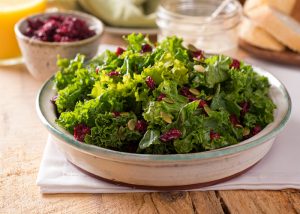
Cruciferous vegetables are a diverse family including broccoli, kale, arugula, brussels sprouts, and cauliflower. This family of vegetables is great for cancer prevention and cardiovascular health.[29] Researchers found an especially strong anti-carcinogenic potential in them because they contain glucosinolate, a secondary plant product. So basically, glucosinolate is like the Superman of fighting cancer! Additionally, the dark leafy greens in this group, such as broccoli, are particularly good for detoxifying your body as they are full of vitamin C.[30]
You can eat these vegetables raw, steamed or cooked. Try kale microgreens, which are high in Vitamin A, in your next salad or inside a sandwich.
Coffee

Black coffee is too bitter for some. But don’t fret, you can still get the same benefits if you add a splash of milk to your cup. The caffeine in coffee stimulates both your cognitive function and your digestion.[31] However, if you’re overly sensitive to stimulants, remember to drink in moderation. Coffee also boosts liver repair, helping cleanse and detox your digestive tract.[32]
If you don’t already, try adding coffee into a morning shake. Or if you’re not into drinking coffee, try chocolate-covered espresso beans. They combine both sweet and bitter taste receptors and are a satisfying snack.
Dandelion Greens
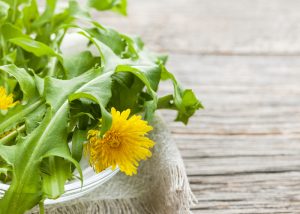
If you’re looking for bitter food examples, you can’t go past dandelion greens. Why? Well, the leaves of dandelions (yes, the cute little weed flowers) are highly nutritious. They’re high in Vitamin C and antioxidants, which can help protect your immune system.[33]
These vitamins also have preventative and therapeutic benefits for cardiovascular diseases.[34] But on top of that, one pilot study showed that ingesting fresh dandelion leaf acted as a mild diuretic in the subjects.[35] Diuretics can be beneficial to health because by encouraging urine flow out of your body, they can help to expel any toxins and waste that your body won’t use.
Dandelion greens would go great in your next salad or sautéed with some bok choy (another great cruciferous veggie) and soy sauce.
Dark Chocolate

Another scrumptious item on our bitter food examples list is dark chocolate. Yes, dark chocolate and its bitter flavor can actually have a positive effect on your body. Cocoa, the bean that chocolate comes from, is rich with polyphenols. Polyphenols stimulate the growth of healthy gut bacteria in your body.[36] The good bacteria in your gut contributes to consistent movement and break down of nutrients. And again, when everything is going well in the gut, your body can expel waste and toxins properly, allowing for a detoxified body.
If you want to get in on the benefits of cocoa in the form of dark chocolate, look for dark chocolate with cocoa content above 70 percent. This will give you maximum antioxidant effect, with minimal sugar, milk, and fat.
Citrus Peel
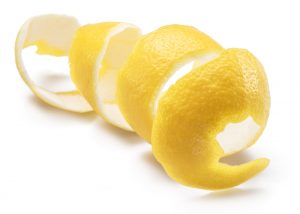
Okay, so not many people want to sink their teeth directly into an orange, peel and all. But the bitter white rind in citrus fruits has some great benefits, and you don’t have to eat it raw! Citrus peels have antioxidants which you can get by eating them directly, or from ingesting the essential oils.[37] A study has also proven that polyphenols are also present in the white rind of these peels,[38] making them a great addition to a smoothie for better gut health.
The next time you reach for a cup of soothing tea, try adding in a lemon peel or two. This not only gives you the oils and lemon flavor from the rind, but it soaks the bitter flesh and allows you to get those health benefits too. You can also candy fruit peels with sugar and eat them as a treat.
Green Tea
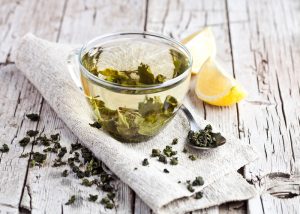
Like many of the above bitter foods, green tea is also high in polyphenols. Additionally, green tea is better for your health than traditional black tea, as green tea tested highest in a study between herbs comparing their antioxidant levels.[39] Another study found that a high intake of green tea yielded a 20 percent reduction in breast cancer risk.[40] The superfood has also been shown to reduce the risk of colon, skin, lung, and prostate cancer.[41]
There is more than one way to get your dose of green tea. There’s the standard loose leaf tea and also matcha green tea powder that you can use in drinks or even baked goods. Both are excellent ways to get a healthy dose of bitter benefit.
Red Wine

Red wine was once used as medicine in ancient times.[42] Today, it’s widely known for its cardiovascular health benefits when consumed moderately but regularly. Red wine is rich with flavonoids, which are known to aid in the creation of digestive enzymes.[43] It also has anti-inflammatory effects, which reduce cancer risk and progression.[44]
If you want to get in on all that red wine has to offer, consider having a glass once or twice per week with dinner. Red wine pairs well with many healthy Italian dishes like fresh tomato pasta, cheese and fruit boards, and veggie lasagna.
Saffron
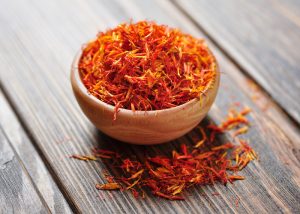
Saffron is a spice that comes from the dried stigmas of the flower commonly known as saffron crocus.[45] It features on this bitter food examples round-up as when consumed regularly, saffron can help gastric disorders and even reduce the risk of Alzheimer’s disease.[46]
Because saffron is one of the most expensive spices in the world, you’ll want to get your money’s worth. First, it needs to first be crushed into a powder form. Then you can add it to dishes or tea for a somewhat pungent, yet floral taste. Saffron goes great in dishes with almonds, apples, cardamom, or cream. Try adding a small pinch in your rice pudding, or into a stew with lentils and coconut milk.
Sesame Seeds
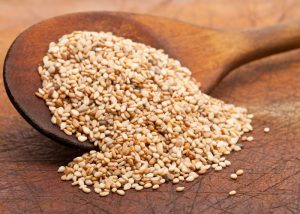
Sesame seeds are an easy way to add more bitterness to your diet. They are high in protein and consist of healthy oils too.[47] One study showed that when eaten regularly, sesame seeds can even help lower cholesterol levels by reducing the bad fat stored in blood cells.[48]
Sesame seeds taste great in many Asian dishes or baked on top of bread. It’s definitely one of the most versatile bitter food examples out there! They have a slightly nutty taste that is great paired with both sweet or umami flavors. Try a sesame-ginger salad dressing for your next lunch.
Jerusalem Artichokes

This bitter food is actually the tuber part of a flowering plant. Jerusalem artichokes are also a functional food that can be used to make inulin, a starch-like ingredient, and fructose.[49] One report also showed that inulin is key in reducing gastrointestinal symptoms (like constipation). This is important if your aim is to detox your gut and make space for new nutrients.[50]
However, Jerusalem artichokes give you the best benefit in their natural, whole vegetable form. Try cutting them into small pieces and roasting them gently at 350℉ for about 45 minutes. Eat it as a side dish or chill them and toss them into a salad.
Cranberries

Cranberries are not usually consumed raw because of its astringent or tart taste. You might be more familiar with them in juice form or dried like raisins. There is also cranberry powder that has all the health benefits of cranberries like anti-inflammation and antioxidants.[51] In terms of digestive health, a study showed that a high intake of cranberries can aid in the prevention of urinary tract infection because of its antibacterial components.[52]
Dried cranberries are great in salads with other fruit or arugula. Just be careful not to eat too many dried fruits as they also carry high sugar content.
Note: Age impacts your perception of bitter foods. As you grow older, your sensitivity to them will decrease. Additionally, women are more sensitive to bitter taste than men.[53]

Conclusion
Bitter flavor is everywhere — from the food you eat, to the spices you use, to regular drinks you consume. This makes it easy to incorporate them into your diet so you can reap their digestive benefits. Using our tips above, you’ll see that the taste can be great too! Now that you know about their countless benefits, don’t be scared to add a new bitter food to your shopping list.
References
- [1] https://academic.oup.com/mbe/article/20/5/805/985520
- [2] https://www.ncbi.nlm.nih.gov/pmc/articles/PMC4622133/
- [3] https://www.sciencedirect.com/science/article/pii/S0960982213004181
- [4] https://www.sciencedirect.com/science/article/pii/S0960982213004181
- [5] https://www.physiology.org/doi/full/10.1152/ajpgi.00073.2006
- [6] https://www.sciencedirect.com/science/article/abs/pii/S0950329317302501
- [7] https://www.sciencedirect.com/science/article/abs/pii/S095816691630266X
- [8] https://www.tandfonline.com/doi/abs/10.1080/10408398.2017.1383355
- [9] https://www.tandfonline.com/doi/abs/10.3109/09637486.2011.627841
- [10] https://www.ncbi.nlm.nih.gov/pmc/articles/PMC4622133/
- [11] https://www.jstor.org/stable/10.1525/gfc.2004.4.3.78?seq=1#page_scan_tab_contents
- [12] https://www.ncbi.nlm.nih.gov/pubmed/11114681
- [13] https://www.sciencedirect.com/science/article/pii/S175646461300193X
- [14] https://www.ncbi.nlm.nih.gov/pmc/articles/PMC5652077/
- [15] https://www.ncbi.nlm.nih.gov/pubmed/26503863
- [16] https://www.gastrojournal.org/article/S0016-5085(10)60204-1/abstract
- [17] https://www.sciencedirect.com/science/article/pii/S2212877818306562
- [18] https://bmcpharma.biomedcentral.com/articles/10.1186/1471-2210-4-18
- [19] https://www.ncbi.nlm.nih.gov/pubmed/20198408
- [20] https://www.ncbi.nlm.nih.gov/pubmed/28467517
- [21] http://www.onegreenplanet.org/natural-health/why-bitter-foods-are-good-for-the-body/
- [22] https://jamanetwork.com/journals/jamainternalmedicine/fullarticle/1105662
- [23] http://www.onegreenplanet.org/natural-health/why-bitter-foods-are-good-for-the-body/
- [24] https://pubs.acs.org/doi/abs/10.1021/jf9709562
- [25] https://www.tandfonline.com/doi/abs/10.1080/13590840802518785
- [26] https://search.proquest.com/openview/11bcb8f2d2327bca1f54af2aacfac509/1?pq-origsite=gscholar&cbl=2030010
- [27] https://www.nidcd.nih.gov/health/statistics/quick-statistics-taste-smell
- [28] https://journals.lww.com/co-psychiatry/Abstract/2015/01000/The_gut_microbiome_and_diet_in_psychiatry___focus.2.aspx
- [29] https://www.sciencedirect.com/science/article/pii/S1756464611000843
- [30] https://search.proquest.com/openview/11bcb8f2d2327bca1f54af2aacfac509/1?pq-origsite=gscholar&cbl=2030010
- [31] https://www.tandfonline.com/doi/abs/10.1080/10408390701522445
- [32] https://onlinelibrary.wiley.com/doi/abs/10.1002/scin.2015.188007017
- [33] http://www.rombio.eu/rbl3vol21/16.%20Sergiu%20Paduret.pdf
- [34] https://www.ncbi.nlm.nih.gov/pubmed/26234792
- [35] https://www.ncbi.nlm.nih.gov/pmc/articles/PMC3155102/
- [36] https://www.sciencedirect.com/science/article/pii/S0955286313000946
- [37] https://pubs.acs.org/doi/abs/10.1021/jf9709562
- [38] https://www.sciencedirect.com/science/article/pii/S1658077X16300960
- [39] https://www.tandfonline.com/doi/abs/10.1080/13590840802518785
- [40] https://www.researchgate.net/profile/Craig_Schneider2/publication/24309791_Green_tea_Potential_health_benefits/links/0a85e52f2986fdb4bf000000/Green-tea-Potential-health-benefits.pdf
- [41] https://www.tandfonline.com/doi/abs/10.1080/10408390802145310
- [42] https://onlinelibrary.wiley.com/doi/full/10.1111/j.1541-4337.2010.00125.x
- [43] https://link.springer.com/article/10.1007%2Fs11101-007-9070-4
- [44] https://onlinelibrary.wiley.com/doi/full/10.1111/j.1541-4337.2010.00125.x
- [45] https://www.researchgate.net/profile/Stella_Ordoudi/publication/286368958_Saffron_A_Functional_Spice/links/56681e3908aea62726f0d5a2/Saffron-A-Functional-Spice.pdf
- [46] https://www.researchgate.net/profile/Stella_Ordoudi/publication/286368958_Saffron_A_Functional_Spice/links/56681e3908aea62726f0d5a2/Saffron-A-Functional-Spice.pdf
- [47] https://www.sciencedirect.com/science/article/pii/S0308814606007205
- [48] https://www.sciencedirect.com/science/article/pii/S0271531705001107
- [49] https://www.sciencedirect.com/science/article/pii/S2215017X14000605
- [50] https://www.sciencedirect.com/science/article/pii/S0144861716303812
- [51] https://academic.oup.com/advances/article/4/6/618/4595566
- [52] https://academic.oup.com/advances/article/4/6/618/4595566
- [53] https://www.researchgate.net/profile/Ch_Schoenberger/publication/263046667_March_April_2006_56_How_does_bitter_taste_perception_work/links/00b7d539a2e3faa167000000/March-April-2006-56-How-does-bitter-taste-perception-work.pdf








